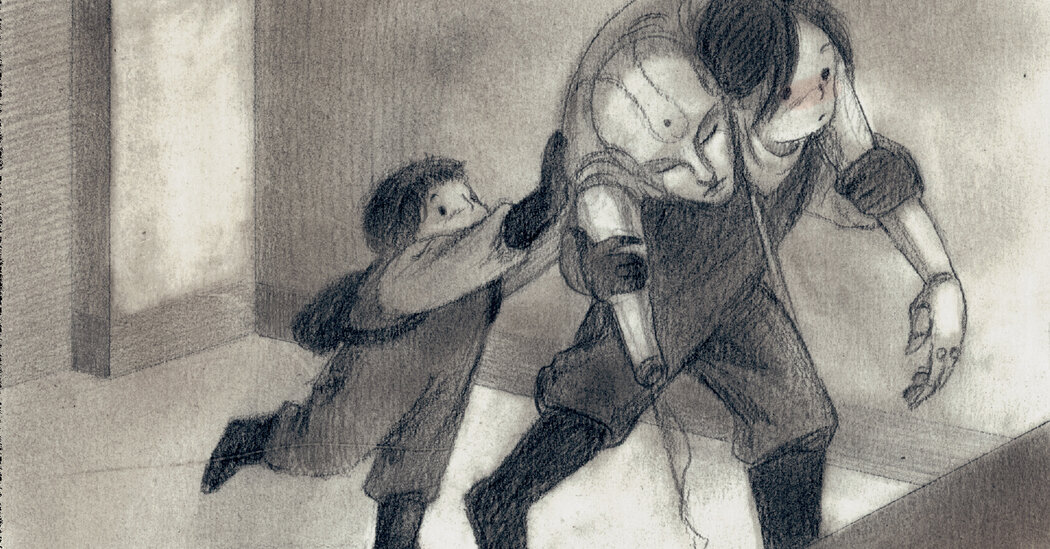In the past few years, my journeys have taken me around the world. My audiences are mostly young people in middle school and high school. No matter the country or continent, they yearn to fit in, to not feel so “different.”
“What Fell From the Sky,” by the Pura Belpré honoree Adrianna Cuevas, and “Oasis,” by the New York Times Best Illustrated Children’s Books Award winner Guojing, will likely resonate with these readers, who will find friends in unexpected places: a six-toed girl from another planet hiding in a family’s barn, “left-behind” children foraging for sustenance in a postapocalyptic world, a robot mom tossed onto a pile of discarded technology.
In both books, the best examples of humanity aren’t necessarily human, and the emotional yearning of the characters, longing for missing parents, is what makes the stories sing.
In WHAT FELL FROM THE SKY (Farrar, Straus & Giroux, 304 pp., $17.99, ages 8 to 12), a meteoroid has landed on Earth, and it’s brought someone with it.
Set in 1952, the novel is based on an actual historical event: The small farming town of Soledad, Texas, has been taken over by the U.S. military under the guise of a Cold War training operation. In addition to propaganda-filled leaflets, soldiers and an overabundance of provisions parachute down outside the school window. A young Cuban American boy, Pineda, rightly suspects there’s more going on than some fabricated war game.
When Pineda discovers a girl hiding in his family’s barn, things take a cosmic turn. Chickens pecking at her six toes hint there’s something unique about her. But blue-gray skin, white-blond hair, and double pupils and eyelids give away her alien origin.
Surrounded by white ranchers, Pineda can relate to feeling otherworldly in this rural Texas town: “Being different is never good,” he imparts.
Unable to understand the girl’s language, Pineda names her Luisa, and promises to keep her safe. The pair must elude the military, which has already imprisoned her “specimen” parents and is bent on capturing her as well.
Told in alternating chapters, from Pineda’s and Luisa’s distinct points of view, the narrative reveals Luisa’s understanding of Earth one tension-building word at a time: “B is for barn”; “H is for hay”; “S is for soldier”; “G is for gun”; “C is for caught.”
All the while, Luisa’s distress is like that of human children separated from their parents: “S is for scared.”
The military leaves a trail of destruction wherever it goes in Soledad. When the townspeople hold a meeting, Pineda courageously steps forward to plead with them to unite against the soldiers. This act of bravery encourages others to speak up. Some of the town’s long-hidden secrets are revealed, which brings the residents closer together.
Tackling serious topics, this moving novel shows how lack of respect for our differences can end in disaster, and how viewing them with an open heart and mind can make us all stronger.
The graphic novel OASIS (Godwin/Holt, 160 pp., $21.99, ages 8 to 12) is set in a postapocalyptic desert.
It’s rare to find a book so thought-provoking and haunting that also feels like it’s welcoming the reader with a warm hug. “Oasis” does just that. Guojing’s pencil illustrations of young, round-faced characters, and her soft shading, bring unusual comfort to a harsh landscape.
The main characters in “Oasis,” JieJie and DiDi (whose names mean “older sister” and “younger brother”), are on their own when we meet them. The children have been left to fend for themselves while their mother toils in the domed city of Oasis — designed, built and run by A.I. robot overlords. She earns what they need to survive and hopes to save enough to buy a pass that would enable them to join her there.
In her absence, the “left-behind children” (whose father is never mentioned) face challenges that range from water rationing to finding shelter from raging sandstorms. Between bowl haircuts and meager food preparation, JieJie does her best to care for her little brother, but there are holes in their hearts where their mom should be.
When the children stumble upon a landfill, they scavenge a dismantled robot and take it home. DiDi makes a wish, asking for a mom, and the obsolete robot answers his call, activating “Mother Mode” to become A.I. Mom.
A.I. Mom swiftly fills the role of their absent human mother, giving them food, clean clothes and … love?
She protects the children from sandstorms and takes them to enjoy a lovely sunset (made possible by the heavily polluted atmosphere). Through poetry, song and dance, she even simulates the moon festival their mother had hoped to take them to.
A.I. Mom’s parenting style is peculiar compared with that of the children’s human mom. But there’s a sameness in the spirit of affection.
Even though A.I. Mom starts out following her programming, as the children’s affection toward her grows we see her blossom with a sense of purpose. Suddenly the robot is a character we relate to.
What will happen when the children’s mother finally arrives home to check on them and finds her daughter and son being cared for by a robot resembling her overlords?
This oddly uplifting story lets readers see how JieJie and DiDi’s once desolate home becomes its own oasis of nurturing, where an unconventional and beautiful family blooms.
For those who insist they don’t like sci-fi (as many young readers I have encountered have expressed), maybe they just haven’t found the right book, with the right interplanetary girl, left-behind child or discarded robot, who like all of us wants safety and a place to belong.
“H is for hope.”
